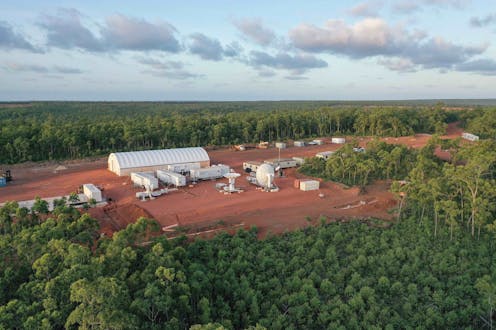NASA to launch 3 rockets from Northern Territory in boost for Australian space efforts
- Written by Melissa de Zwart, Professor (Digital Technology, Security and Governance), Flinders University

Over the next month, NASA will launch three rockets[1] from the Arnhem Space Centre in the Northern Territory on the Dhupuma Plateau, near Nhulunbuy. The rockets are 13 metre “sounding” rockets that will not reach orbit but will take scientific observations.
The launches represent a number of firsts for the Australian space industry. They also represent a major step forward for commercial space operators, as well as signalling the opportunity for future joint projects between Australia and the United States.
The launches
The Arnhem Space Centre is owned and operated by a commercial operator, Equatorial Launch Australia. It is located on the land of the Gumatj people, who as the traditional custodians of the land, have been consulted as part of the launch approval process.
Gumatj Corporation chair Djawa Yunupingu told the ABC[2] last year the launch plans are “a step towards the future for our people”.
This is the first time NASA has conducted a rocket launch from a commercial facility outside the US. This involves a significant logistical undertaking, with each rocket delivered to the launch site via barge[3].
More than 70 NASA personnel[4] will travel to the NT to support the launch and the scientific program.
The rockets have been designed and built by NASA and will be used for scientific investigations into the physics of the Sun, astrophysics and the type of planetary science we can only conduct in the southern hemisphere. After the launches, NASA says it will[5] clean up all material such as casing and payloads and return it to the US.
The NASA contract was first announced in 2019[6]. However, COVID lockdowns and travel restrictions have delayed the launches until now.
What else is likely to be launched from this site?
Equatorial Launch Australia also plans to construct a larger launch facility, with three launch pads, accommodating larger rockets and payloads.
Several more launches are planned[7] this year. The company is aiming to have 50 or more launches a year by 2024 and 2025.
What does this mean for the future of the Australian space industry?
The Arnhem Space Centre is one of three proposed commercial launch sites in Australia.
In September 2020 another operator, Southern Launch, conducted sub-orbital launches from its Koonibba Test Range[8] in South Australia, which is operated with[9] the Koonibba Community Aboriginal Corporation.
Southern Launch has also recently obtained a licence to operate its own commercial launch site, Whaler’s Way Orbital Launch Complex[10], on the Eyre Peninsula.
Read more: 3, 2, 1...liftoff! The science of launching rockets from Australia[11]
Gilmour Space Technologies has applied for a licence[12] to undertake launches from Bowen in North Queensland. Its application is supported by the Queensland government and the Juru people[13], who are the traditional owners of the land. The company plans to build and launch its own rockets from this site.
Decades of disappointment
The development of an Australian launch capability will be a big step for the country’s space industry.
In the 1960s, Australia’s launch facilities at Woomera in South Australia were used as part of the European Launcher Development Organisation[14] (ELDO) project.
In 1967, Australia became the fourth nation in the world[15] to launch a domestic-built satellite from its own territory. That satellite, the WRESAT, was launched from Woomera on an American Redstone rocket, and stayed in orbit until early 1968.
However, Australia lost interest in launching rockets when ELDO relocated to French Guiana.
In the early 1990s, an American company expressed interest in building a launch facility[17] in Australia. However, those plans never materialised.
Onwards and upwards
In recent years, Australia’s interest in space science has been returning. However, even when the Australian Space Agency was created in 2018 there was some doubt[18] over whether we would be able to carry out our own launches.
These latest developments make it clear we will. Prime Minister Anthony Albanese described[19] the launches as a project to “bring together global and local industry to take Australia’s space sector into a new era”.
Read more: No launch from Australia: something missing from our plans for the new space race[20]
Australia has also signed the Artemis Accords[21], joining the Artemis program to return humans to the Moon and on to Mars. The Artemis Accords were developed by NASA as “a shared vision for principles, grounded in the Outer Space Treaty of 1967, to create a safe and transparent environment which facilitates exploration, science, and commercial activities for all of humanity to enjoy”.
Enrico Palermo, Head of the Australian Space Agency, said[22] the Northern Territory launch would “further cement our reputation as a nation that global space players want to do business with”.
With new businesses and jobs at stake, this is an important move forward for Australia’s re-emergence as a serious space operator.
References
- ^ launch three rockets (ela.space)
- ^ told the ABC (www.abc.net.au)
- ^ via barge (www.abc.net.au)
- ^ 70 NASA personnel (www.spaceconnectonline.com.au)
- ^ says it will (www.abc.net.au)
- ^ announced in 2019 (www.spaceconnectonline.com.au)
- ^ are planned (www.spaceconnectonline.com.au)
- ^ Koonibba Test Range (www.southernlaunch.space)
- ^ operated with (www.southernlaunch.space)
- ^ Whaler’s Way Orbital Launch Complex (www.southernlaunch.space)
- ^ 3, 2, 1...liftoff! The science of launching rockets from Australia (theconversation.com)
- ^ has applied for a licence (www.abc.net.au)
- ^ the Juru people (www.australiandefence.com.au)
- ^ European Launcher Development Organisation (en.wikipedia.org)
- ^ fourth nation in the world (www.naa.gov.au)
- ^ CPL Bill Solomou/AAP (photos.aap.com.au)
- ^ building a launch facility (www.slq.qld.gov.au)
- ^ some doubt (theconversation.com)
- ^ described (www.pm.gov.au)
- ^ No launch from Australia: something missing from our plans for the new space race (theconversation.com)
- ^ Artemis Accords (www.nasa.gov)
- ^ said (www.minister.industry.gov.au)


















